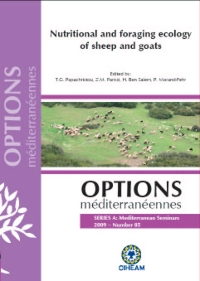| Article précédent | p. 153-157 | Article suivant |
The mineral content of river saltbush (Atriplex amnicola) changes when sodium chloride in the irrigation solution is increased
Chenopod shrubs accumulate Na, K and Cl. There is little information available on factors affecting the accumulation of these and other minerals in the plants. In this experiment, the accumulation of Na, Cl, K, Ca, S, P, Mg, Cu, Zn and Mn was analysed in river saltbush (Atriplex amnicola). Six different river saltbush genotypes (cloned from different geographical regions) were grown in the glasshouse and irrigated with 1 of 5 NaCl concentrations (0, 50, 100, 200 or 400 mM). There were 6 replicates of each treatment (180 plants in total). Plants were harvested, dried and analysed after 8 weeks of treatment. Increasing the NaCl applied increased (P < 0.05) the concentrations of Na (+290%), Cl (+260%) and Mn (+36%) but decreased (P < 0.05) K (-47%), S (-18%), Ca (-46%), Cu (-43%) and Zn (-45%). Na and K concentrations in young river saltbush grown in the low NaCl irrigation solution were not high enough to depress intake or production of ruminants. At NaCl concentrations above 100 mM, the Na and K concentrations in the plants would be predicted to significantly depress intake and growth. The S and Mg concentrations in young river saltbush plants, at all levels of NaCl treatment, were above maximum tolerable levels for ruminants and may depress intake and production. The depression in concentration of K, Ca, Cu and Zn at high NaCl treatments may also predispose ruminants to deficiencies or imbalances depending on the fertility of soil and water.
Les chénopodes accumulent Na, K, et Cl. On dispose de peu d'information sur les facteurs qui affectent l'accumulation de ces minéraux ou d'autres minéraux dans ces plantes. Dans la présente expérience, l'accumulation de Na, Cl, K, Ca, S, P, Mg, Cu, Zn et Mn a été étudiée dans le buisson de milieu saumâtre Atriplex amnicola. Six génotypes différents de cette espèce (clonés à partir de différentes régions) ont été plantés sous serre et irrigués avec une des cinq concentrations suivantes de chlorure de sodium : 0, 50, 100, 200 ou 400 mM. Chaque traitement a été répété 6 fois (180 plantes en tout). Les plantes ont été récoltées, séchées et analysées après 8 semaines de traitement. L'augmentation de NaCl a augmenté (P < 0,05) les concentrations de Na (+290%), Cl (+260%) et Mn (+36%), mais a diminué (P < 0,05) celles de K (-47%), S (-18%), Ca (-46%), Cu (-43%) et Zn (-45%). Les concentrations de Na et K dans les jeunes plants élevés avec la solution d'irrigation à faible teneur en Na n'étaient pas assez élevées pour réduire leur consommation par les ruminants ou leurs performances zootechniques. A des concentrations de NaCl supérieures à 100 mM, on peut s'attendre à une réduction significative de la consommation et de la croissance chez les animaux. Quel que soit le niveau de salinité étudié, les concentrations de S et de Mg dans les jeunes plantes ont été au-dessus des limites tolérables pour les ruminants et pourraient réduire leur consommation et les performances de croissance des animaux. Les concentrations réduites de K, Ca, Cu et Zn pourraient aussi prédisposer les ruminants à des déficiences ou des déséquilibres en fonction du sol et de l'eau.
- [ Afficher ]
- [ Télécharger ]
- [ Exporter la citation ]
Vous pouvez télécharger la citation au format :
- [ Imprimer ]
-
Mots-clés
ARBUSTE, CUIVRE, MILIEU SAUMATRE, MINERAUX, NUTRITION ANIMALE, RUMINANT, SODIUM, SOUFRE, VALEUR NUTRITIVECiter cet article
Masters D., Tiong M., Norman H., Vercoe P.E. The mineral content of river saltbush (Atriplex amnicola) changes when sodium chloride in the irrigation solution is increased. In : Papachristou T.G. (ed.), Parissi Z.M. (ed.), Ben Salem H. (ed.), Morand-Fehr P. (ed.). Nutritional and foraging ecology of sheep and goats. Zaragoza : CIHEAM / FAO / NAGREF, 2009. p. 153-157. (Options Méditerranéennes : Série A. Séminaires Méditerranéens; n. 85). 12. Seminar on: Nutritional and Foraging Ecology of Sheep and Goats, 2007/10/11-13, Thessaloniki (Greece). http://om.ciheam.org/om/pdf/a85/00801000.pdf



